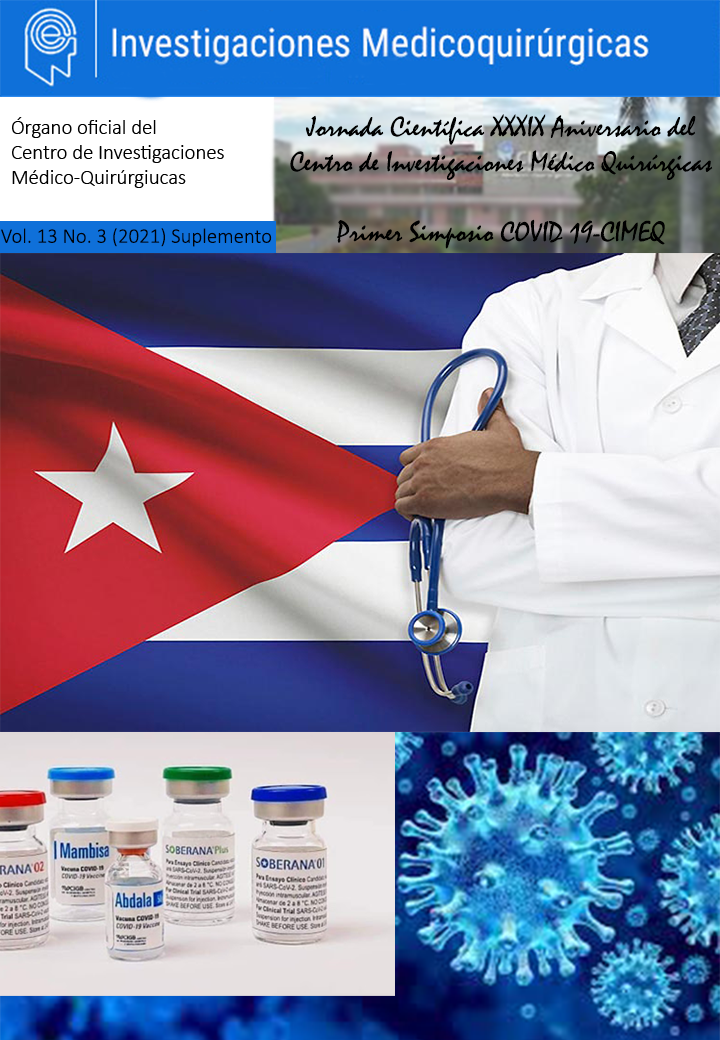Tratamiento de la distonía cráneo-cervical con toxina botulínica tipo A (Xeomen)
Resumen
Introducción. La distonía cráneo-cervical constituye una de las distonías segmentarias más frecuentes. Numerosos tratamientos han sido ensayados para esta enfermedad; la toxina botulínica tipo A ha sido usada como tratamiento desde la década del 80 del siglo pasado. Métodos. Estudio prospectivo en 23 pacientes con distonía cráneo-cervical a los cuales se les administró toxina botulínica tipo A (Xeomen). Resultados. El inicio del efecto clínico fue de 5,65 días. El efecto máximo a los 28,35 días. La duración máxima del efecto de 3,67 meses. Después de la administración de la toxina se observó un 60,20% de incremento de la actividad, dos pacientes presentaron complicaciones (ptosis palpebral y lagrimeo), lo que resulta un nivel de tolerancia a la toxina botulínica tipo A de un 87%. Conclusiones. La toxina botulínica resultó ser efectiva en el tratamiento de la distonía cráneo-cervical, el blefaroespasmo tipo tónico respondió mejor y la respuesta fue evidente desde el día de la aplicación. Las complicaciones del proceder fueron mínimas.
Citas
Fahn S. The varied clinical expressions of dystonia. In Jankovic J, ed Movement disorders. Neurologic clinics. Vol 2. Philadelpfia: WB Saunders, 1984; pp 541-554.
Meige H. Les convulsions de la face: une forme clinique de convulsione faciales, bilateral y mediane. Rev Neurol (Paris) 1910; 21: 437-443.
Jankovic J, Leder S, Warner D, Schwartz K. Cervical dystonia: clinical findings and associated movement disorders. Neurology 1991; 41: 1088-1091.
Muller J, Kemmler G, Wissel J, Schneider A, Voller B, Grossmann J, Diez J, Homann N, Wenning GK, Schnider P, Poewe W; Austrian Botulinum Toxin and Dystonia Study Group. The impact of blepharospasm and cervical dystonia on health-related quality of life and depression. J Neurol 2002 Jul;249(7):842-6.
Fahn S, Marsden CD, Calne DB. Dystonia: advances in neurology. Vol 50. New York: Raven Press, 1988.
Frueh BR, Felt DP, Wojno TH, Muesh DC. Treatment of blepharospasm with botulinum toxin: A preliminary report. Arch Ophfhalmol 1984; 102: 1464-1468.
Mitchell F. Brin. Botulinum Toxin: Chemistry, Pharmacology, Toxicity and Inmunology. Muscle Nerve (suppl. 6) 1997; S146-167.
Singer C. Indications and management of botulinum toxin. Rev Neurol 1999 Jul 16-31;29(2):157-62.
Huber A. Botulinum toxin and the eye. Curr Probl Dermatol 2002;30:227-35
O'Day J. Use of botulinum toxin in neuro-ophthalmology. Curr Opin Ophthalmol 2001 Dec;12(6):419-22.
Anderson RL, Patel BC, Holds JB, Jordan DR. Blepharospasm: past, present, and future. Ophthal Plast Reconstr Surg 1998 Sep;14(5):305-17.
Van den Bergh PY, Lison DF. Dose standardization of botulinum toxin. Adv Neurol 1998;78:231-5.
Tolosa E, martí MJ. Blepharospasm-oromandibular dystonia symdrome (Meige´s syndrome): clinical aspects Adv Neurol 1988; 49: 73-84.
Thussu A, Barman CR, Prabhakar S. Botulinum toxin treatment of hemifacial spasm and blepharospasm: objective response evaluation. Neurol India 1999 Sep;47(3):206-9.
Grandas f, Elston J, Quinn N, Marden CD. Blepharospasm: review of 264 patients. J Neurol Neurosurg Psychiatry 1988; 51: 767-772.
Mauriello JA Jr, Dhillon S, Leone T, Pakeman B, Mostafavi R, Yepez MC. Treatment selections of 239 patients with blepharospasm and Meige syndrome over 11 years. Br J Ophthalmol 1996 Dec;80(12):1073-6.
Andrade LA, Borges V, Ferraz HB, Azevedo-Silva SM. Botulinum toxin A: experience in the treatment of 115 patients. Arq Neuropsiquiatr 1997 Sep;55(3B):553-7.
Nussgens Z, Roggenkamper P. Comparison of two botulinum-toxin preparations in the treatment of essential blepharospasm. Graefes Arch Clin Exp Ophthalmol 1997 Apr;235(4):197-9.
Drummond GT, Hinz BJ. Botulinum toxin for blepharospasm and hemifacial spasm: stability of duration of effect and dosage over time. Can J Ophthalmol 2001 Dec;36(7):398-403.
Boghen DR, Lesser RL Blepharospasm and hemifacial spasm. Curr Treat Options Neurol 2000 Sep;2(5):393-400.
Hsiung GY, Das SK, Ranawaya R, Lafontaine AL, Suchowersky O. Long-term efficacy of botulinum toxin A in treatment of various movement disorders over a 10-year period. Mov Disord 2002 Nov;17(6):1288-93.
Dutton JJ. Botulinum-A toxin in the treatment of cranio-cervical muscle spasms: short- and long-term, local and systemic effects. Surv Ophthalmol 1996 Jul-Aug;41(1):51-65.
Descargas
Cómo citar
Número
Sección
Licencia
Los autores conservan los derechos de autor y todos los derechos de publicación sin restricciones.
Investigaciones Medicoquirúrgicas se encuentra sujeta bajo la Licencia Creative Commons Atribución-No Comercial 4.0 Internacional (CC BY-NC 4.0) y sigue el modelo de publicación de SciELO Publishing Schema (SciELO PS) para la publicación en formato XML.
Usted es libre de:
- Compartir — copiar y redistribuir el material en cualquier medio o formato
- Adaptar — remezclar, transformar y construir a partir del material.
La licencia no puede revocar estas libertades en tanto usted siga los términos de la licencia
Bajo los siguientes términos:
- Atribución — Usted debe dar crédito de manera adecuada, brindar un enlace a la licencia, e indicar si se han realizado cambios. Puede hacerlo en cualquier forma razonable, pero no de forma tal que sugiera que usted o su uso tienen el apoyo de la licenciante.
- No Comercial — Usted no puede hacer uso del material con propósitos comerciales.
- No hay restricciones adicionales — No puede aplicar términos legales ni medidas tecnológicas que restrinjan legalmente a otras a hacer cualquier uso permitido por la licencia.
Avisos:
- No tiene que cumplir con la licencia para elementos del material en el dominio público o cuando su uso esté permitido por una excepción o limitación aplicable.
- No se dan garantías. La licencia podría no darle todos los permisos que necesita para el uso que tenga previsto. Por ejemplo, otros derechos como publicidad, privacidad, o derechos morales pueden limitar la forma en que utilice el material.



